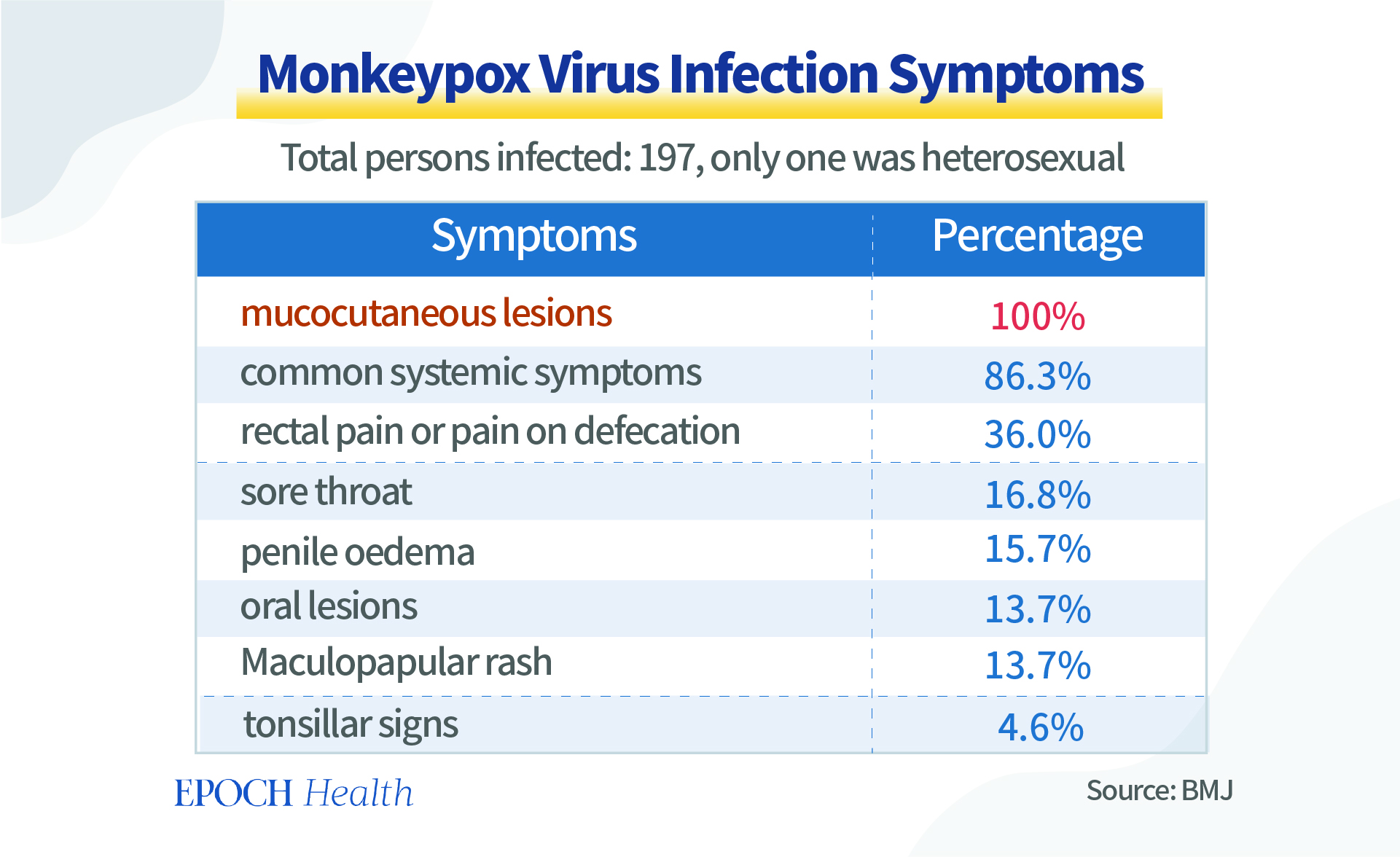Monkeypox has been spreading in many countries. Many media and public health agencies have consistently emphasized that monkeypox mainly spreads through contact via the skin in their public statements, educational flyers, and media articles in the last few months. However, more research found that monkeypox mainly spread through sexual contact.
New England Journal of Medicine (NEJM) published a study on 528 Monkeypox virus infections across 16 countries between late April and late June. Overall, 98 percent of the persons with infection were gay or bisexual men, and transmission was suspected to have occurred through sexual activities in 95 percent of the persons with infection.
UK Health Security Agency also warned that the monkeypox outbreak continues to grow and cases remain primarily in gay, bisexual, or men who have sex with men (MSM).
There is more evidence showing that the monkeypox virus is spreading through sexual contact. Many symptoms are similar to those of sexually transmitted infections.
A paper published in the British Medical Journal found all infections have mucocutaneous lesions. In addition to the most common systemic symptoms of fever, lymphadenopathy, and myalgia, other symptoms include rectal pain, penile swelling, and oral lesions, all of which are symptoms of sexually transmitted diseases.
A portion of those infected with monkeypox have concomitant sexually transmitted infections. For example, a paper published in Infection describes a 40-year-old male who went to the hospital with a red spot on the tip of his nose. It was initially thought to be a sunburn. But within three days, the skin in the nasal area progressed to necrosis. In parallel, typical monkeypox virus lesions (confirmed by PCR) appeared on the whole body with serious infection of the penis and oral mucosa.
The patient had never been tested for sexually transmitted diseases (STD) before. Further tests revealed that he had an advanced HIV infection.
Other statistics show that 35.5 percent of those who were infected with monkeypox virus are HIV positive. About one third of monkeypox virus infections also have other sexually transmitted infections, such as gonorrhea (Neisseria gonorrhoeae), chlamydia (Chlamydia trachomatis), herpes, and syphilis (Treponema pallidum).
Monkeypox Virus and HIV Infect the Same Group of People
In fact, sexual minority groups are exposed to bigger health risks. As mentioned in the aforementioned article, over one third of people infected with monkeypox also are HIV positive, which is another huge health threat.
According to CDC statistics in 2020, 68 percent of HIV virus infection happened among men who have sex with men.

Another high risk group for HIV infection is transgender women. The risk factor of this group is 49 times that of the general population. This might be because the sex reassignment surgery could damage the immune system making the person more susceptible to virus.
Some people argue that the mentioning of these statistics is discrimination against the sexual minority group. But, in fact, only by objectively discussing the potential health risks can the public protect themselves better. This is a responsible approach to public health.
We are obligated to remind the public, especially the youth, about the risk factors in different forms of sexual behaviors and the transgender procedures, just as it’s important as reminding children to wash their hands before eating. Many people feel that it is politically correct to not talk about the health risks specifically for LGBTQ people. However, it is bona fide negligence or discrimination and violation of ethics rules to intentionly hide, or not inform of the health risks related to these communities or anyone who intends to make a similar choice of lifestyle. NOT telling the facts will harm people more. A good medicine might taste bitter.
Male-to-male Sexual Contact: High Risk of Contracting These Diseases
In addition to monkeypox and HIV, there are other diseases that can easily transmit through male-to-male sexual contact.
Human Papillomavirus (HPV)
There are many types of HPV, some of which are hard to cure. Even though there are drugs and vaccines for it, they don’t provide complete protection.
It’s very common for people with HIV to carry HPV, especially for men who have sex with men (MSM). National LGBT Cancer Network statistics show that anal HPV is present in approximately 65 percent of MSM who are HIV negative, and 95 percent of MSM who are HIV positive. Homosexual men are more susceptible to HPV infection than females, no matter whether they are HIV positive or negative.
CDC statistics show that gay, bisexual, and other men who have sex with men have a higher chance of getting viral hepatitis including Hepatitis A, B, and C, which are diseases that affect the liver. About 10 percent of new Hepatitis A and 20 percent of all new Hepatitis B infections in the United States are among gay and bisexual men. There are vaccines against Hepatitis A and B, but not C. Experts recommend that all gay and bisexual men be vaccinated for Hepatitis A and B.
Male to male sexual contact brings much higher risk of contracting gonorrhea and syphilis. CDC statistics on syphilis cases in the United States from 2007 to 2013 shows syphilis infections increasing among men who have sex with men.

A research published in Clinical Infectious Diseases found that the highest risk of anal cancer is in HIV positive men who have sex with men.

Mental Health Issues in Homosexuals
In addition to health concerns related to gay men, lesbians are also suseptible to cancer, STDs, high blood pressure, HIV, mental disorder, and drug abuse.
A survey done with 1,925 lesbians from all 50 states showed that about three fourths had received counseling at some time during the past year, and half had done so for reasons of sadness and depression. About half were not able to perform normal daily activities due to mental issues. More than one third of the participants had depression and 21 percent had suicidal thoughts.

Mental disorders can exacerbate other issues, such as smoking, drinking, drug abuse. Mental disorders can prevent the person from following procedures to treat other diseases resulting in cancer and HIV.
Is Sexual Orientation Determined by Genetics?
The physical and mental health issues among sexual minority groups are more severe than what the public know about. Many conditions plague the person for life.
Some youth are confused about their own sexual orientation. But before they make a decision regarding their sexual orientation, they are not fully aware of the associated health risks.
To truly respect life, we must face these issues and tell people the truth. Our society is still lacking when it comes to educating our youth about these issues.
So, what determines a person’s sexual orientation?
Many think that genetics determines a person’s sexual orientation and can’t be changed. But a report in Science magazine refutes this notion.
The report analyzed three independent studies and concluded that even though five autosomal loci were found to be associated with same-sex sexual behavior, there is not a single gene found to determine the sexual orientation of an individual.
Moreover, sociocultural influences on sexual preference might interact with genetic influences. A person’s postnatal selections, habits, behaviors can also have an influence. To certain extent, a person’s intention and thoughts can also influence sexual orientation.
So, a person’s sexual orientation is determined by a complex combination of factors, and not by a single gene expression. Many media reports ignore this point, the same way they ignore the health issues of this group of people.
To the public, especially the youth, before they make a big decision such as changing their sexual identity, it is very important for them to know the risk factors associated, either short term, long term, physical, or mental. Parents, teachers, media agencies, and community advocates are all obligated to educate the public about the health risk factors in this issue.
Considering the continuing spread of monkeypox virus, now is also the right time to update the educational flyers or website information for health departments or agencies regarding the transmission routes of monkeypox virus. The success of monkeypox vaccination campaigns among LGBTQ communties also requires honest and effective education with true information.
Views expressed in this article are the opinions of the author and do not necessarily reflect the views of The Epoch Times. Epoch Health welcomes professional discussion and friendly debate. To submit an opinion piece, please follow these guidelines and submit through our form here.
Discovered on: 2022-09-14 17:24:20
Source: Monkeypox Is Primarily Spread Through Sexual Contact



